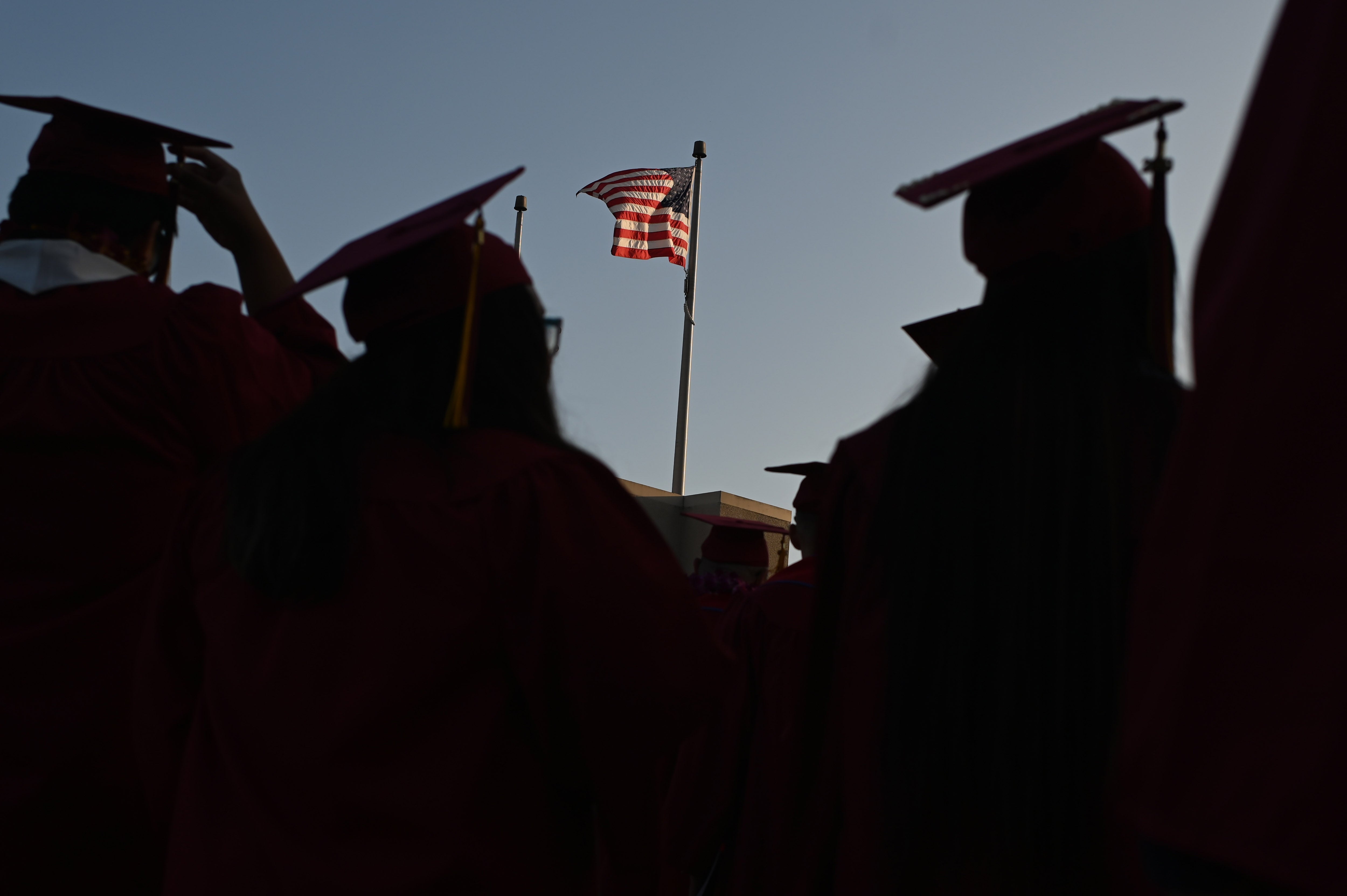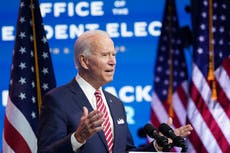‘Exhausted, depressed, defeated’: The far-reaching impacts of America’s student debt crisis
The weight of student debt has put millions of Americans in a bind, as organisers and activists demand an end to a growing burden, writes Alex Woodward


Your support helps us to tell the story
From reproductive rights to climate change to Big Tech, The Independent is on the ground when the story is developing. Whether it's investigating the financials of Elon Musk's pro-Trump PAC or producing our latest documentary, 'The A Word', which shines a light on the American women fighting for reproductive rights, we know how important it is to parse out the facts from the messaging.
At such a critical moment in US history, we need reporters on the ground. Your donation allows us to keep sending journalists to speak to both sides of the story.
The Independent is trusted by Americans across the entire political spectrum. And unlike many other quality news outlets, we choose not to lock Americans out of our reporting and analysis with paywalls. We believe quality journalism should be available to everyone, paid for by those who can afford it.
Your support makes all the difference.Staring down $146,000 in student loan debt, with interest rates as high as 11.75 per cent, the numbers on Victoria’s bills don’t ever seem to get any smaller. She paid more than $11,000 in interest alone last year.
“I owe more now than I did when I took out the loans,” said Victoria, a 2013 graduate of the Savannah College of Art and Design, a prestigious private art school in Georgia.
Supported by a combination of federal loans and loans through Wells Fargo, with an income-based repayment plan through the Department of Education, she has not been able to lower or consolidate payments because of a high debt-to-income ratio, and the debt was too high to re-finance through a third party, she said.
“You don’t make enough money and you have too much debt, and we can’t help you restructure the debt so you can pay it because you don’t make enough money,” she told The Independent, “but you better pay it on time, even though we know you don’t make enough money to pay these monthly bills.”
She would come home from work “exhausted, depressed and just feeling defeated” – she found a job she liked at a restaurant, “and discovered I actually am pretty good at this and mostly enjoy it. I’m lucky and happy to be where I’m at now but it’s definitely not where I thought I’d be 11 years ago,” she said. “And to be honest every time I pay my monthly bill ... I feel a little tinge of guilt and failure because I’m still paying for a degree I do not use.”
But that looming debt has clouded the future for her and her fiance: “How could we afford another mouth to feed while staying on top of bills and saving for a house? What about health insurance? Another car? School fees and clothing? Saving for their college fund so they don’t end up in the same place as me?”
‘Ridiculous, complex, infuriating’
More than 45 million Americans hold more than $1.6 trillion in student loan debt, a figure that has surged within the last decade as private university enrollment grew and federal and state governments made steep cuts to higher education funding against growing wealth inequality. Within the next four years, if unchecked, outstanding student debt is expected to hit $2tn. That doesn’t include money borrowed by students’ parents.
Borrowers who spoke with The Independent said that their debt had effectively put their lives into a bind, trapped by debilitating and endless payments compounded by interest rates, and worsened by psychological stress from financial insecurity, fearing bankruptcy or worse.
They survived a recession only to feel the weight of their debt during a pandemic and inadequate government relief that has worsened insecurities, threatened livelihoods and put millions of Americans out of work.
President-elect Joe Biden has supported cancelling $10,000 in loan debt through legislation, though he’ll face stiff opposition in GOP-controlled Senate. One measure, from senators Chuck Schumer and Elizabeth Warren, proposes that Biden cancel up to $50,000 in debt, along with any tax penalties, and pause future federal loan payments and interest through the duration of the pandemic.
A growing body of progressive lawmakers, activists and advocacy groups are pressuring the incoming administration to cancel a massive amount of debt through executive action without having to rely on Congress at all.
The average monthly student loan payment among US borrowers is $393. Graduates from the class of 2019 owe an average of nearly $30,000. Those debts soar among postgraduate degree holders, of which nearly a quarter owe $100,000 or more.
The Department of Education reports that about 20 per cent of borrowers are in default – or have not made a payment within at least 270 days – while millions of borrowers are behind. More than 1 million loans go into default each year.
More than 90 per cent of that outstanding debt is in the form of government loans, according to the Consumer Finance Protection Bureau. That leaves more than $130bn of outstanding loans from private institutions.
Over the last several decades, federal and state governments have stripped funding for higher education, while tuition has spiked, federal policy changes effectively eliminated limits on borrowing, and predatory lending schemes and sky-high interest rates have trapped a generation of borrowers into a lifetime of debt.
In the 1970s, federal grants covered up to 80 per cent of student costs for undergraduates. That figure has plummeted by more than half. Average annual costs at public institutions, including tuition and housing, have reached nearly $22,000 for in-state universities and more than $38,000 for out-of-state universities, according to the Center on Budget and Policy Priorities. A year at a private university costs more than $49,000, on average.
The pandemic, its economic fallout and inadequate federal relief have likely exacerbated the crisis. A Pew survey earlier this fall found that 58 per cent of borrowers whose payments had been suspended during the pandemic would have difficulty paying them if they were to return.
Earlier this year, Pew found that roughly 70 per cent of Americans believed taking out student loans is a reasonable choice given the benefits of a college degree, but 89 per cent also worried about the ability to pay for them.
“These problems indicate that the repayment system is not effectively facilitating affordable repayment in a way that helps borrowers and taxpayers,” Pew found. “To improve outcomes and boost borrowers’ long-term repayment success, policymakers should be guided by the significant challenges facing current borrowers.”
The weight of all that debt also has severe long-term consequences among borrowers who default, from damaged credit to the risk of having driver’s or professional licenses suspended, depending on the state and type of loan involved, according to Pew.
Through pandemic relief, interest has been suspended for approximately 41 million borrowers relying on federal student loans; payments for 33 million of those borrowers have paused, and the Education Department has stopped collecting from 8 million others who were in default.
“I’m super thankful that we’re talking about cancelling some student debt but desperately await a better option” than Biden’s proposal to cancel up up to $10,000 in federally backed loans, Victoria said.
“What about the insane interest rates private lenders demand? Or the ridiculous, complex, and infuriating system private lenders have in place to refinance/consolidate? What about the rest of my federal loans? What happens with the interest rate on those? Because I could just end up owing the ‘cancelled’ amount in interest in a year.”
Organising against debt
The public health crisis and government inaction with looming evictions and mass unemployment has revealed the depth of inequality in the US, while the cycle of American debt – high rates of borrowing at sky-high interest to compensate for low wages – masks the scale of the crisis, with mass debt becoming a major driver of financial insecurity.
“The suffering is extremely real,” the Debt Collective’s Thomas Gorkey told The Independent. “At the same time, if debt organising and debt resistance is ever going to take off, this is the moment. … The real economic pain in families’ lives is deep."
Modeling itself after labour unions in the wake of the Occupy Wall Street movement, the Debt Collective has worked to eliminate more than $1bn in borrowers’ debts, with the aim of abolishing “every penny, no exceptions” for student borrowers, Grokey said.
Young Democratic Socialists of America, the youth-led political organisation within the booming DSA movement, and students across the US have also joined demands to cancel debt.
“For most student borrowers, that debt rules their lives – locked into jobs they don’t want, from having families,” said Labiba Chowdhury, a City College of New York student and YDSA co-chair. “The second I have to start paying again, I’m going to struggle with that. I have to balance paying rent and debt … In the middle of this pandemic, millions of other Americans are in the same struggle.”
YDSA has launched a campaign urging president-elect Biden to cancel debt by executive order, part of its broader College For All initiative, organising around tuition-free public college, and ending profit-driven education.
“Student debt relief is the first step towards that, fighting for a future where anyone can get an education without having to worry about how to pay for it,” Chowdhury told The Independent.
YDSA’s chapter at Columbia University-Barnard College in New York – one of the most expensive universities in the US, with annual tuition topping $61,000 – launched a tuition strike against the university’s “exorbitant tuition rates” that “constitute a significant source of financial hardship during the pandemic,” the group said.
More than 2,700 students signed on to the strike, pledging to withhold tuition for the spring 2021 semester along with future donations to the campus after graduation.
Its demands include a 10 per cent reduction in tuition and 10 per cent increase in financial aid, among others, including an end to the campus extension into West Harlem, support for campus unions, defunding its campus police and increased transparency about the university’s financial holdings.
“The tuition strike demands letter calls on the university to recognise these movements and give students a more democratic say over the cost of tuition and how it is spent,” the strikers said in a statement. “The students organising the tuition strike view it as a last-resort tactic to compel the university to listen to demands that students have been organizing around for the past few years.”
‘Psychologically devastating’
Jack, a 2010 graduate of the University of Texas at Austin, said his initial $6,000 loan from a now-defunct private lender has ballooned into a $14,000 to $17,000 “zombie loan that hangs over me just waiting to bankrupt me one day.”
He fears his financial insecurity has put pressure on his marriage and wracked him with guilt.
He secured a loan through MyRichUncle, which offered loans based on grade performance rather than ability to pay. The interest rate was roughly 13 per cent.
“Since it’s a private loan I had no federal protection, and they hounded me pretty hard right up until they went bankrupt,” he said. “They then sold my debt to another company, then another. I’ve lost count. I’ve ridden out the statute of limitations but I keep worrying I’ll do something to restart the clock, and at last check the balance was almost triple what it was originally.”
MyRichUncle was among the largest student loan lenders, alongside Sallie Mae, Citibank, and JPMorgan Chase. It filed for bankruptcy in 2007.
The bills started appearing under other company names, then came debt collectors collecting on their behalf.
If his debt was cancelled, “it’d mean I could start thinking about going back to school and learning a new skill,” he said. “I’d like to pivot into some other fields and it’s hard to get back into school with old debt.”
Kaitlin, a 2008 graduate of Appalachian State University, accrued $130,000 in debt after graduation, stuck with a $700 bill each month, with interest, “and it just kept growing,” she said.
The burden of debt became “psychologically devastating,” she said. “I’d wake up in the middle of the night thinking my life was bought, like someone else owned my life.”
But her debt burden unexpectedly shrank overnight. Her mother received a significant amount of money following the death of a great uncle in 2015; she offered to pay off more than a third of her debt.
“Overnight I went from having a $700 bill every month to having $700 free,” she said. “I spent a lot of time crying because I couldn't believe it.”
With more flexibility to find work that didn’t require full-time employment just to pay off her loans, she found part-time work that brought her closer to the job she wanted, “and got really into organising, and was able to get a job that’s a union job, that’s more than I need to live,” she said.
“If I still had that debt, I would still be clinging to whatever miserable job I had to make sure I paid it every month,” she said. “I would still probably be working jobs that barely paid my rent, barely met the minimum of what I needed to survive.”

Join our commenting forum
Join thought-provoking conversations, follow other Independent readers and see their replies
Comments